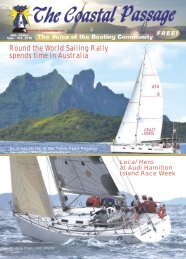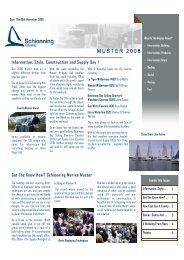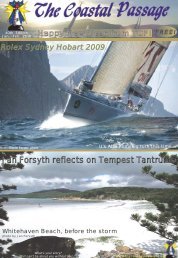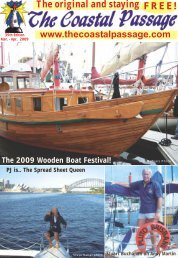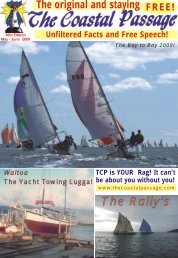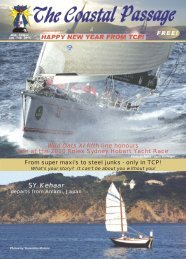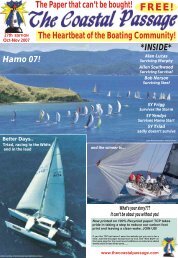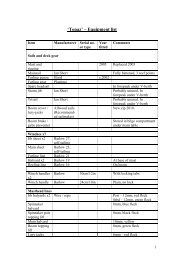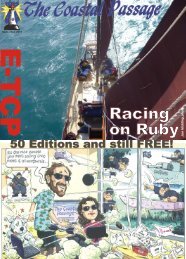TCP A 45 PG 1 - The Coastal Passage Home Page
TCP A 45 PG 1 - The Coastal Passage Home Page
TCP A 45 PG 1 - The Coastal Passage Home Page
Create successful ePaper yourself
Turn your PDF publications into a flip-book with our unique Google optimized e-Paper software.
<strong>The</strong> following is part of the notice from AQIS/DAFF:<br />
<strong>The</strong> import conditions for used vessels with timber in their<br />
construction and/or fit-outs have now been revised. What<br />
has changed?<br />
From 1 July 2010 all used vessels arriving in Australia (either as<br />
cargo or sailed in) will be assessed as either low risk or high risk<br />
for timber pests and diseases exotic to Australia. This policy<br />
replaces the previous Category 1, 2 and 3 inspection processes<br />
and offshore fumigation certification is no longer being accepted<br />
as an alternative to this on arrival assessment process.<br />
Each consignment must be accompanied by sufficient<br />
documentation to allow AQIS to determine the vessel's age,<br />
country of manufacture, construction, former location/s, and<br />
travel and treatment history. Vessels arriving without the<br />
required documentation and/or vessel history will automatically<br />
be regarded as high risk vessels.<br />
Low risk vessels are those with minimal timber in their<br />
construction and fit-outs OR if more than minimal timber NOT<br />
manufactured/re-fitted in a high risk country AND has not spent<br />
three or more months (cumulative) in high risk countries. As<br />
examples, AQIS considers that vessels with minimal timber in<br />
construction and fit-out may include (but are not restricted to):<br />
* vessels generally with fibreglass, composite or steel hulls and<br />
non timber masts<br />
* internal fit-outs that are mainly with Medium Density<br />
Fibreboard (MDF) or particle board or other composite timber<br />
like products, with solid timber only being used in trims.<br />
<strong>TCP</strong> note: upon being made aware of this, <strong>TCP</strong> posted a link<br />
on our website to inform boaties of this and received the<br />
following letter:<br />
Hi and thanks for your work.<br />
I read this (AQIS notice) with interest as I am considering buying<br />
a UK boat that is now in the USA???? Well I don't know. I am<br />
after a hull that is very similar to the Couta Boats. I wrote to an<br />
agent in the USA and the response:<br />
“I just read your email and the attached pdf about importing of<br />
vessels with timber construction. At first blush it seems to me<br />
that this would restrict ALL importation of ANY boat built unless it<br />
was steel or aluminium. All production fibreglass boats use a<br />
significant amount of plywood for bulkheads and interior<br />
furniture. <strong>The</strong> only difference in the construction of the Martin<br />
Heard is that the house and deck are built using plywood and<br />
then coated 100% in fibreglass instead of the production<br />
standard of using balsa or foam core in these areas to save<br />
weight. I can't imagine that this boat or any other with plywood<br />
bulkheads would be excluded from importation. I think that the<br />
caveat of what country it was built in might make a difference.<br />
<strong>The</strong> pdf you sent did not have a list of those countries. I can<br />
understand that the government does not want to import leaky<br />
teakys or pallets of wood filled with pests but I can't imagine that<br />
they would limit importation of production built boats or boats<br />
built to that standard. That would be a pretty serious trade<br />
embargo that would have popped up in our industry publications<br />
and forums and I have not seen anything like that. I am hoping<br />
that this document reads in a much more frightening manner<br />
than it is in practice. I will do some research and see if I can learn<br />
more and get back to you. Please let me know if you find out<br />
anything more. Can you call the agency in question and discuss<br />
this matter and see if we have interpreted it correctly?”<br />
I wondered if any of your readers could offer some responses??<br />
Cheers, Steve T<br />
Greetings Steve T,<br />
Once again.. a protocol established for a purpose that seems out<br />
touch. That is… it's not like Australia is free from termites now<br />
and AQIS have not provided any support for the necessity of this<br />
protocol.<br />
And the ambiguity... literal or common sense interpretation of the<br />
rule? Good luck, bad luck... It's interesting to note that the ply I<br />
am using for construction is imported from "high risk" countries.<br />
Also note that there is only one approved inspection service in<br />
Australia so far, on the Gold Coast. It would be up to you entering<br />
to obtain a private service that AQIS would accept, more<br />
ambiguity.<br />
Remember the "bio-fouling" scare a few years ago? For a time<br />
AQIS was using video cameras to inspect bums and really<br />
leaning hard on sailors for documentation of last anti-foul. This<br />
has cooled since, perhaps because the imagined threat didn't<br />
materialise, as I predicted it would not 5 years ago.<br />
see the report:<br />
http://thecoastalpassage.com/biofoul.html<br />
Also, I think the remarks in the announcement about the<br />
exclusion of MDF and particle board are interesting. I think it<br />
would be the odd boat that would have such material in<br />
construction.<br />
Cheers, Bob<br />
Hi Bob and Kay,<br />
Your night at the Southern Bay of Goldsmith Island as reported<br />
on page 9 of <strong>TCP</strong> #44 brought back an old memory from 1963,<br />
when I was caught in the same bay-same circumstances, with<br />
the only engine power being a Seagull outboard. So, like you,<br />
we hung in there with coral close behind us, until daylight gave<br />
us the opportunity to beat out of there. I guess we remember<br />
these incidents so we can hopefully avoid the same situation in<br />
the future.<br />
This year, in August, we were anchored at Long Beach at the<br />
Southern end of Great Keppel Island sheltering from a Northerly<br />
with a South Westerly change due but had our move planned for<br />
the change that came at midnight, as they seem to know how to<br />
do.<br />
Remembering early situations reminds us to be ready for a<br />
necessary move in the middle of the night but what a difference<br />
GPS and a plotter makes<br />
Cheers,<br />
Denis & Maureen Lobb, MB Focus<br />
Hallo Kay and Bob,<br />
Was a great article by Stuart, " Going Overboard" <strong>TCP</strong> 42, have<br />
attached a photo of an innovation that may make it more easy<br />
hanging on while she rounds up. It should be of some help to<br />
those of us who are more feeble than we were.<br />
Kerry Parker<br />
and views<br />
From <strong>TCP</strong> 40 PAGE 9<br />
Are HF Weather<br />
Forecasts in Danger?<br />
<strong>TCP</strong> readers responded and,<br />
(gasp!) government listened!<br />
From <strong>The</strong> BOM:<br />
<strong>The</strong> Bureau is taking steps to improve marine weather<br />
services based on results from a survey conducted in<br />
early 2010.<br />
Marine webpages:<br />
<strong>The</strong> survey showed an increasing number of boaters are<br />
relying on the Bureau's marine services to plan their trip,<br />
particularly looking at winds, waves, tides and ocean<br />
currents. As a result, the Bureau is planning to release a<br />
new wave model on its website in late July 2010, with 7<br />
day forecast maps of weather patterns, wind speeds,<br />
swell heights, swell periods and wind waves.<br />
To improve the range of services it provides for mariners,<br />
the Bureau has embarked on a 4-year project to upgrade<br />
forecast services around Australia. New services will<br />
include interactive maps of highly detailed marine<br />
forecasts with the ability to view forecast information for<br />
the next 7 days at any location. For recreational boaters in<br />
capital city areas, maps of forecast wind speed, wind<br />
waves and swell will be provided on a three hourly basis<br />
for the next 3 days.<br />
Marine radio services<br />
Some respondents were dissatisfied with the Bureau's HF<br />
radiofax, and marine radio broadcasts. As part of its<br />
commitment to providing weather information on marine<br />
radio services, the Bureau is working with its partners to<br />
improve the quality and coverage of HF and VHF marine<br />
radio fax and voice broadcasts. Many respondents<br />
commented that they weren't aware of the services<br />
available by marine radio, and the Bureau is planning to<br />
increase promotion of these services over the coming<br />
summer. New guidelines are being developed to ensure<br />
broadcasts provided by Bureau forecasters contain the<br />
relevant content and detail that mariners require.<br />
Accessing the website whilst on the water<br />
Many respondents said they were accessing the Bureau's<br />
site via laptop and mobile phone. As a result, the Bureau<br />
will maintain text only versions of forecasts and warnings<br />
to ensure low download costs on satellite internet and<br />
viewing on mobile phones. Webpage layouts will continue<br />
to be designed with mobile users in mind.<br />
<strong>The</strong> survey results provide a great range of feedback for<br />
the Bureau to further improve its services to the marine<br />
community. With exciting new developments coming<br />
online, mariners can be assured the Bureau is committed<br />
to providing high-quality and relevant information they can<br />
rely on.<br />
First of all the document doesn't say those vessels are excluded<br />
but rather may incur expense in clearance for inspection and<br />
possible treatment /<br />
fumigation.<br />
Also not ALL composite boats are built with ply furniture and<br />
bulkheads, but mine is. Thus, I pursued the matter myself. I<br />
called the 1800 number on the AQIS web site and was given the<br />
harshest possible interpretation from a person named "Tim".<br />
That is, with my timber bulkheads and arriving back from three<br />
months in Asia, I would be considered, “high risk”. I asked "Tim"<br />
what countries were considered "high risk" and was told all of<br />
Asia, Africa, South America and all Polynesia except Vanuatu<br />
and NZ. I was then referred to an individual in Darwin (Liz<br />
Regeling 08 8920 7019) that assured me she was the last word<br />
and she indicated a boat like mine would not be considered "high<br />
risk" upon re-entry. But I do note that the text in the document<br />
was read differently by the previous official.<br />
Hey Kerry, what a good idea!<br />
To bring readers up to speed, Stuart Buchanan had discussed<br />
overboard strategies for the single handed sailor, including a<br />
devise to swing the helm to cause the boat to round up but he<br />
also tried the trailing line approach and found it impossible to<br />
hang onto even at relatively slow speeds. Your solution Kerry,<br />
would keep the line floating and visible and provide a platform<br />
that may enable a person to cling to the line and even pull<br />
themselves back aboard. Well done!<br />
Cheers,<br />
Bob<br />
<strong>TCP</strong> note: <strong>The</strong> above is an edited version of the<br />
document, the full version may be viewed at their site<br />
from this link,<br />
http://www.bom.gov.au/marine/about/notices/serviceimprovements2010.shtml<br />
BOM representative Neal Moodie was very<br />
cooperative and <strong>TCP</strong> did issue hard questions to<br />
insure bureaucratic speak was not being used to cover<br />
decreasing radio coverage which was a major concern<br />
to readers. “ <strong>The</strong> Bureau is committed to providing Marine<br />
broadcasts to mariners at sea, and Inmarsat, HF and VHF<br />
services are continuing under their existing<br />
arrangements.”<br />
<strong>TCP</strong> wishes to note that the BOM website is under<br />
continuing improvement and services and information<br />
offered is world class. We are happy to see however, that<br />
BOM is not abandoning craft dependence on radio.<br />
www.blueseamachines.com.au<br />
peter@blueseamachines.com.au<br />
<strong>The</strong> <strong>Coastal</strong> <strong>Passage</strong> #<strong>45</strong> 2010 <strong>Page</strong> 7





